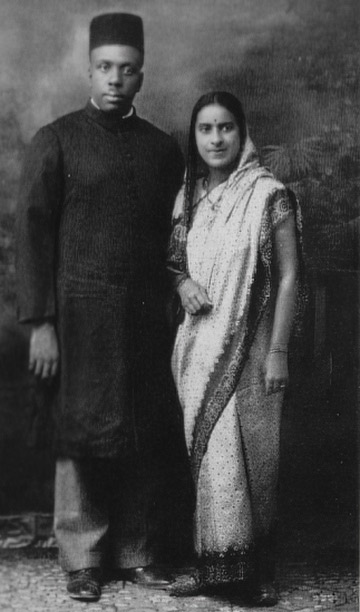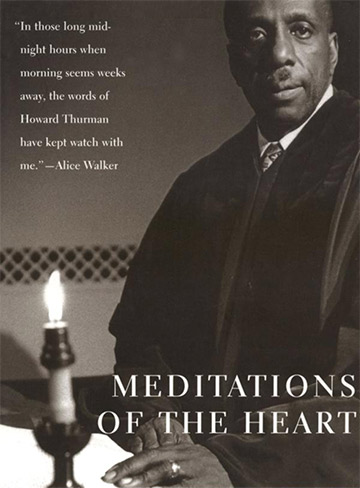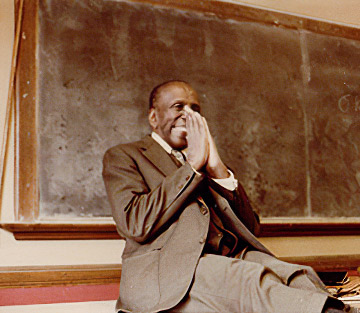This excerpt is adapted from Dr. Craig Pearson’s popular collection The Supreme Awakening: Experiences of Enlightenment Throughout Time—And How You Can Cultivate Them. For more inspiring excerpts, see the Enjoy TM News article “Making Friend of Foe, Making Love of Hate”: Howard Thurman’s Enlightened Vision.
Howard Thurman (1899–1981) was a Baptist minister, civil rights leader, philosopher, theologian, educator, author, and one of the most important figures in African American history. He profoundly influenced a generation of black ministers and civil rights leaders with his American interpretation of Mahatma Gandhi’s principles of nonviolent civil disobedience.1

Howard Thurman and his wife Sue Bailey Thurman on their “Pilgrimage of Friendship” to India, 1935
As theologian Luther E. Smith, Jr., has written, “Howard Thurman was a spiritual genius who transformed persons who transformed history.”2
Thurman was born in Florida and grew up in a world of segregation. At Morehouse College, where he was a classmate and friend of Martin Luther King, Sr., he graduated first in his class. In divinity school he was ordained a Baptist minister at 26. He became the Dean of Chapel and a faculty member in the School of Divinity at Howard University in Washington, D.C.
In 1935 Thurman went to India on a “Pilgrimage of Friendship” to meet two people he revered: Gandhi and the poet Rabindranath Tagore. Gandhi’s philosophy of satyagraha, or “soul force,” had a deep impact on Thurman, revealing for him the effectiveness of nonviolent resistance.
In 1944 he co-founded the Church for the Fellowship of All Peoples in San Francisco, the first racially and culturally integrated church in the United States.
Thurman then went to Boston University, where he taught in the School of Theology and served as Dean of Chapel, the first African American to hold a deanship at a predominantly white university. There he mentored Dr. Martin Luther King, Jr., who he introduced to Gandhi’s philosophy of nonviolent resistance.
“Howard Thurman was a spiritual genius who transformed persons who transformed history.” —Luther E. Smith, Jr.
“The Region of the Great Silence”
Thurman wrote 20 books, all beautifully composed, deeply felt reflections on life and living. One theme that runs through his writing is the experience of profound, inner peace and silence, as in the following passage from his book, The Inward Journey:

Howard Thurman’s The Inward Journey was published in 1961
“There is no clear distinction between mind and spirit; but there is a quality of mind that is more than thought and the process of thought. This quality involves feelings and the wholeness in which the life of man has its being . . .
“What is being considered is what a man means totally when he says, ‘I am.’ This ‘self’ shares profoundly in the rhythm that holds and releases but never lets go. There is the rest of detachment and withdrawal when the spirit moves into the depths of the region of the Great Silence, where world weariness is washed away and blurred vision is once again prepared for the focus of the long view, where seeking and finding are so united that failure and frustration, real though they are, are no longer felt to be ultimately real” (from “The Need for Periodic Rest,” The Inward Journey).3
Thurman describes a region deep within himself that he calls “the Great Silence.” Settling inward, beyond sense perception, he feels withdrawn from everything. This process brings deep rest that refreshes the body and clears the mind. In this silence he experiences “the wholeness in which the life of man has its being.” Here, “seeking and finding” become united in the experience of the divine and the meaning of all things.
In our practice of the Transcendental Meditation® (TM®) technique, we have all experienced the mind settling down to deeper levels of inner quiet and calm. This is called “transcending.” It may be a vague experience, or sometimes it can be very clear: for a brief moment or longer, the mind slips into that state of profound silence. There is no mantra, no thought—just inner wakefulness.
As Thurman writes, this experience is deeply restorative.
“. . . there is a quality of mind that is more than thought and the process of thought. This quality involves feelings and the wholeness in which the life of man has its being . . .” —Howard Thurman
The Universality of Higher States of Consciousness
Thurman articulates inexpressible experiences of transcendence and enlightened life in his writing. Like others through history, he describes exalted periods of extraordinary wakefulness, freedom, and bliss—as different from our ordinary waking state as waking is from dreaming.

The second edition of Dr. Craig Pearson’s popular book contains more experiences of awakening to Cosmic Consciousness
The great work of Maharishi Mahesh Yogi, Founder of the TM program, was to bring to light, from the world’s most ancient continuous tradition of knowledge, a simple, natural, and effortless procedure for experiencing the fourth state of consciousness, or Transcendental Consciousness: the Transcendental Meditation technique.
Thurman’s work offers an opportunity for greater understanding of higher states of consciousness as described by Maharishi. When we first learn the TM technique, we typically experience the unbounded awareness of the fourth state only for brief moments during meditation. But in time, with regular, twice-daily experience, the mind becomes so familiar with this unbounded pure awareness that we begin to maintain the experience of it for longer periods—first during meditation and then outside of meditation as well.
Gradually, this experience of Transcendental Consciousness becomes permanent, forming an underlying continuum that coexists with waking, dreaming, and sleeping. These three states continue to come and go, but pure consciousness remains constant. The awareness of the Self is never extinguished.
This is a fifth state of consciousness, altogether different from waking, dreaming, sleeping, and Transcendental Consciousness. Maharishi termed this fifth state Cosmic Consciousness because it is all-inclusive and all-encompassing.
Thurman articulates inexpressible experiences of transcendence and enlightened life in his writing.
Have you had experiences of transcending during your TM practice or growing experiences of Cosmic Consciousness in your life that you would like to share? We are collecting written experiences from TM Meditators around the world and would like to include yours. Please note: We never share any information without your expressed permission. Please let us know via the Comment section at the end of this article and we’ll contact you.
“The Central Stillness”
Thurman describes how inner silence can become a permanent feature of one’s experience, which suggests something like Cosmic Consciousness:

Howard Thurman’s Meditations of the Heart, published in 1953
“It is a central stillness of spirit that is so vital that it can tame the wildness out of almost any tempest, however raging it may be… This fact must not blind us to the great power that there is in what is here referred to as the central stillness. For it is in the quiet which invades us and which becomes a characteristic of our total respiration that we are most acutely aware of the operation of the Presence of God” (from “Be Still and Cool in the Mind,” Meditations of the Heart).4
Thurman also describes experiencing two dimensions simultaneously—ordinary experience plus a “beyond dimension” that transcends all boundaries:
“A good life is what a man does with the details of living if he sees his life as an instrument, a deliberate instrument in the hands of Life, that transcends all boundaries and all horizons. It is this beyond dimension that saves the individual life from being swallowed by the tyranny of present needs, present hungers, and present threats. This is to put distance within the experience and to live the quality of the beyond even in the intensity of the present moment” (from The Inward Journey).5
With this experience, one may enjoy a sense of distance from ordinary experience and become “a deliberate instrument in the hands of Life.” Thurman’s words point toward Cosmic Consciousness, where the mind is established in the transcendent and one’s thoughts and actions are in harmony with natural law, nourishing everything.
“It is this beyond dimension that saves the individual life from being swallowed by the tyranny of present needs, present hungers, and present threats. This is to put distance within the experience and to live the quality of the beyond even in the intensity of the present moment.” —Howard Thurman
“Radical Amazement”
Human beings are also capable of transcending ordinary sense perception, Thurman asserts. As an example, he offers his own experience of a sunset where, beyond the beauty we are accustomed to, a door opens to a timeless dimension, beautiful beyond words:

Howard Thurman at Boston University, where he was Dean of Chapel
“What is forgotten is the fact that life moves at a deeper level than the objective and the data of our senses. We are most alive when we are brought face to face with the response of the deepest thing in us to the deepest thing in life. Consider the hackneyed illustration of the beautiful sunset! We see the sunset, we recognize color, shape, the general quality of the atmosphere—to these we respond. Then when in the midst of all this, something else emerges—the sunset opens a door in us and to us, to another dimension, timeless in quality, that can be described only as ineffable, awe-inspiring—then we know radical amazement” (from “Radical Amazement,” The Inward Journey).6
Here Thurman describes a subjective counterpart of refined perception—the upsurge of radiant joy from deep within, so powerful that all of life is perceived in its glorious light and even pain and sorrow are transmuted into expressions of joy:
“There are other moments when one becomes aware of the thrust of a tingling joy that rises deep within until it bursts forth in radiating happiness that bathes all of life in its glory and its warmth. Pain, sorrow, grief are seen as joy ‘becoming,’ and life gives a vote of confidence to itself, defining its meaning with a sureness that shatters every doubt concerning the broad free purpose of its goodness” (from “The Binding Unity,” The Inward Journey).7
“Then when in the midst of all this, something else emerges—the sunset opens a door in us and to us, to another dimension, timeless in quality, that can be described only as ineffable, awe-inspiring—then we know radical amazement.” —Howard Thurman
“A Unity That Binds All Living Things into a Single Whole”
The purpose of human life, Thurman asserts, is to live wholeness of life, to live in harmony with oneself and with nature—qualities of life fulfilled in Cosmic Consciousness. Achieving this wholeness, Thurman maintains, will create heaven on earth:
“Thou art made for wholeness,
Body, mind, spirit: one creative synthesis,
Moving in perfect harmony within, without,
With fellow man and nature all around
To make Heaven where Hell is found.”
(from “All Mysteries and All Knowledge,” The Inward Journey)8
Even as a boy, Thurman glimpsed the ultimate unity of life. This experience evidently grew as he moved through adulthood:

Howard Thurman was one of the most important figures in African American history
“There is a unity that binds all living things into a single whole. This unity is sensed in many ways. Sometimes, when walking alone in the woods, far from all the traffic which makes up the daily experience, the stillness settles in the mind. Nothing stirs. The imprisoned self seems to slip outside its boundaries and the ebb and flow of life is keenly felt. One becomes an indistinguishable part of a single rhythm, a single pulse. . .
“There is nothing new nor old, only the knowledge that what comes as the flooding insight of love binds all living things into a single whole. The felt reverence spreads and deepens until to live and to love are to do one thing. . .
“And yet there always remains the hard core of the self, blending and withdrawing, giving and pulling back, accepting and rejoicing, yielding and unyielding—what may this be but the pulsing of the unity that binds all living things in a single whole—the God of life extending Himself in the manifold glories of His creation?” (from “The Binding Unity,” The Inward Journey).9
When his mind becomes still and “the imprisoned self” expands beyond boundaries, Thurman experiences the underlying, unified wholeness of life all around him. He feels indistinguishably part of this single wholeness. Reverence and adoration expand to encompass everything. He finds his innermost self to be the divine, creative essence that pervades and unifies everything.
Thurman pictures a world in which people live in wholeness, in harmony with themselves, with natural law, and with each other. His words point toward Cosmic Consciousness, where the mind is established in the transcendent and one’s thoughts and actions are in harmony with natural law, nourishing everything.
This is the world that Maharishi envisioned, and it was to help create such a world—heaven on earth—that he came out of the Himalayas to bring the TM technique to our global family.
“Thou art made for wholeness,
Body, mind, spirit: one creative synthesis,
Moving in perfect harmony within, without,
With fellow man and nature all around
To make Heaven where Hell is found.”
—Howard Thurman
Have you had experiences of transcending during your TM practice or growing experiences of Cosmic Consciousness in your life that you would like to share? We are collecting written experiences from TM Meditators around the world and would like to include yours. Please note: We never share any information without your expressed permission. Please let us know via the Comment section at the end of this article and we’ll contact you.
References
1. Quinton Dixie and Peter Eisenstadt, “When Howard Thurman Met Mahatma Gandhi: Nonviolence and the Civil Rights Movement,” Beacon Broadside (Oct. 2, 2014), from Visions of a Better World: Howard Thurman’s Pilgrimage to India and the Origins of African American Nonviolence (Boston: Beacon Press, 2011), https://www.beaconbroadside.com/broadside/2014/10/when-howard-thurman-met-mahatma-gandhi-nonviolence-and-the-civil-rights-movement.html.
2. Luther E. Smith, “Foreword,” Howard Thurman: Sermons on the Parables, edited by Gowler, David, B., Jensen, Kipton, E. (Maryknoll, NY: Orbis Books, 2018), [no p. nos.].
3. Howard Thurman, “The Need for Periodic Rest,” The Inward Journey (Richmond, Indiana: Friends United Press, 1961), 112.
4. Thurman, “Be Still and Cool in the Mind,” Meditations of the Heart (Boston: Beacon Press, 1953), 24.
5. Thurman, “A Good Death,” The Inward Journey, 25.
6. Thurman, “Radical Amazement,” The Inward Journey, 19–20.
7. Thurman, “The Binding Unity,” The Inward Journey, 52.
8. Thurman, “All Mysteries and All Knowledge,” The Inward Journey, 90.
9. Thurman, “The Binding Unity,” The Inward Journey, 51–52.

Craig Pearson, Ph.D., is the author of The Supreme Awakening: Experiences of Enlightenment Throughout Time—And How You Can Cultivate Them, and Vice President of Academic Affairs at Maharishi International University in Fairfield, Iowa.
Order a copy of The Supreme Awakening ►
Find out more about Maharishi International University ►


What a beautifully written and expressed article. Thank you so much for writing it and for sharing it. And for introducing me to Howard Thurman. I must now go and find books and articles written by, and about, this extraordinary man.